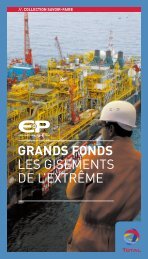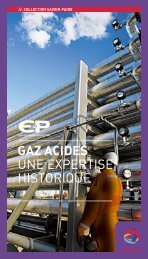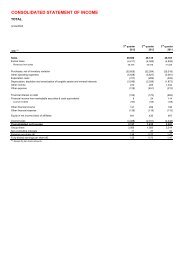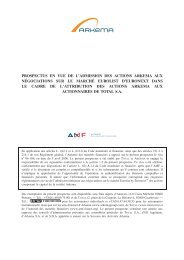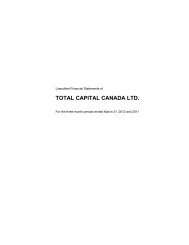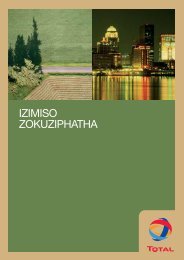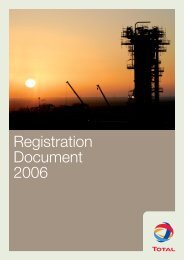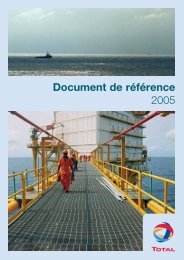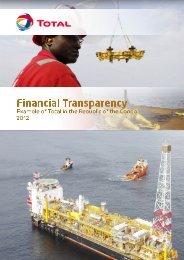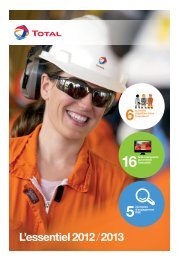Registration Document 2005 - Total.com
Registration Document 2005 - Total.com
Registration Document 2005 - Total.com
Create successful ePaper yourself
Turn your PDF publications into a flip-book with our unique Google optimized e-Paper software.
Exploration & Production<br />
Exploration and development<br />
TOTAL’s Upstream segment intends to continue to <strong>com</strong>bine longterm<br />
growth and profitability at the level of the best in the industry.<br />
TOTAL evaluates exploration opportunities based on a variety of<br />
geological, technical, political and economic factors (including taxes<br />
and concession terms), as well as on projected oil and gas prices.<br />
Discoveries and extensions of existing discoveries accounted for<br />
approximately 73% of the 2,607 Mboe added to the Upstream<br />
segment’s proved reserves during the three-year period ended<br />
December 31, <strong>2005</strong> (before deducting production and sales of<br />
reserves in place and adding any acquisitions of reserves in place<br />
during this period). The remaining 27% <strong>com</strong>es from revisions.<br />
TOTAL continued to follow an active exploration program in<br />
<strong>2005</strong>, with exploration expenditures of consolidated subsidiaries<br />
amounting to 644 M€ (including unproved property acquisition<br />
costs). The principal exploration expenditures were made in Nigeria,<br />
Angola, the United Kingdom, Norway, Congo, the United States,<br />
Libya, Algeria, Argentina, Kazakhstan, Colombia, Indonesia and<br />
the Netherlands. In 2004, the Group’s exploration expenditures<br />
amounted to 651 M€, principally in the United States, Nigeria,<br />
Angola, the United Kingdom, Libya, Algeria, Congo, Kazakhstan,<br />
Norway, Bolivia, the Netherlands, Colombia and Indonesia. In 2003,<br />
exploration expenditures amounted to 630 M€ principally in Nigeria,<br />
Kazakhstan, the United States, Libya, Angola, the United Kingdom,<br />
the Netherlands, Norway, Bolivia, Algeria, Congo, Brunei, Brazil and<br />
Venezuela.<br />
The development expenditures of the Group’s consolidated<br />
Exploration & Production subsidiaries amounted to 5.2 B€ in <strong>2005</strong>,<br />
primarily in Norway, Angola, Nigeria, Kazakhstan, Indonesia, the<br />
United Kingdom, Qatar, Congo, Azerbaijan, Gabon, Canada and<br />
Yemen. 2004 development expenditures amounted to 4.1 B€.<br />
The principal development investments for 2004 were carried<br />
out in Norway, Angola, Nigeria, Indonesia, Kazakhstan, the<br />
United Kingdom, Qatar, Azerbaijan, the United States, Gabon,<br />
Congo, Libya, Trinidad & Tobago, Venezuela and Iran. In 2003,<br />
development expenditures amounted to 3.8 B€ and were made<br />
principally in Norway, Angola, Nigeria, Indonesia, the United States,<br />
Iran, the United Kingdom, Gabon, Azerbaijan, Qatar, Congo and<br />
Venezuela.<br />
Reserves<br />
Business overview<br />
Exploration & Production - Upstream<br />
TOTAL - <strong>Registration</strong> <strong>Document</strong> <strong>2005</strong><br />
2<br />
The definitions used for proved, proved developed and proved<br />
undeveloped oil and gas reserves are in accordance with the<br />
applicable U.S. Securities & Exchange Commission regulation,<br />
Rule 4-10 of Regulation S-X. Proved reserves are estimated using<br />
geological and engineering data to determine with reasonable<br />
certainty whether the crude oil or natural gas in known reservoirs is<br />
recoverable under existing economic and operating conditions.<br />
This process involves making subjective judgments. Consequently,<br />
measures of reserves are not precise and are subject to revision.<br />
The estimation of proved reserves is controlled by the Group<br />
through established validation guidelines. Reserves evaluations are<br />
established annually by senior level geoscience and engineering<br />
professionals (assisted by a central reserves group with significant<br />
technical experience) including reviews with and validation by senior<br />
management.<br />
Significant features of the reserves estimation process include:<br />
•<br />
internal peer reviews of technical evaluations also to ensure that<br />
the SEC definitions and guidance are followed, and<br />
•<br />
a requirement that management make significant funding<br />
<strong>com</strong>mitments toward the development of the reserves prior to<br />
booking.<br />
TOTAL’s oil and gas reserves are reviewed annually to take<br />
into account, among other things, production levels, field<br />
reassessments, the addition of new reserves from discoveries and<br />
acquisitions, disposals of reserves and other economic factors.<br />
Unless otherwise indicated, references to TOTAL’s proved reserves,<br />
proved developed reserves, proved undeveloped reserves and<br />
production reflect the entire Group’s share of such reserves or<br />
production. TOTAL’s worldwide proved reserves include the proved<br />
reserves of its consolidated subsidiaries as well as its proportionate<br />
share of the proved reserves of equity affiliates and of two<br />
<strong>com</strong>panies accounted for by the cost method.<br />
For further information concerning changes in TOTAL’s<br />
proved reserves at December 31, <strong>2005</strong>, 2004 and 2003, see<br />
“Supplemental Oil and Gas Information (Unaudited)”, included on<br />
page 231 and after.<br />
Rule 4-10 of Regulation S-X requires the use of the year-end price,<br />
as well as existing operating conditions, to determine reserve<br />
quantities. Reserves at year-end <strong>2005</strong> have been determined<br />
based on the Brent price on December 31, <strong>2005</strong> ($58.21/b).<br />
13




